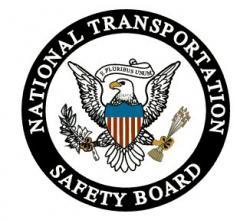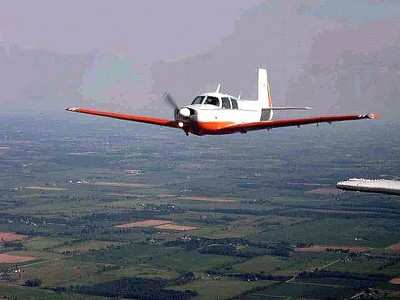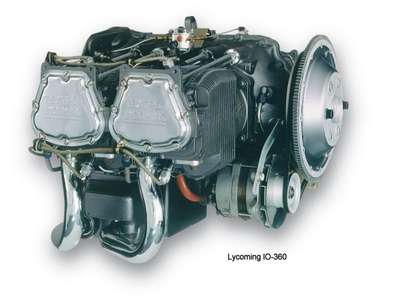Cites No Abort Attempt Despite Failure To Achieve Takeoff
Speed
 The NTSB has released its report of
probable cause in the May 2006 crash of a Mooney
M20E (file photo of type below) piloted by South Carolina's
Lieutenant Governor Andre Bauer.
The NTSB has released its report of
probable cause in the May 2006 crash of a Mooney
M20E (file photo of type below) piloted by South Carolina's
Lieutenant Governor Andre Bauer.
In its report, the NTSB cites Bauer's failure to abort the
takeoff when the aircraft failed to achieve takeoff speed. The
aircraft collided with trees and power lines off the end of a
private, 1,383 foot long and 80 foot wide, dirt and grass,
unregistered, private airstrip near Blacksburg, SC. After the
aircraft came to rest, it caught fire, and although Bauer and his
passenger were both injured, they exited the aircraft.
This was Bauer's first visit to the private airport. He told the
NTSB he hadn't conducted any performance planning for either his
arrival or departure -- the extent of his mission planning seems to
be a phone call to the airport owner to arrange transportation to a
friend's house nearby.
During the call the airport's owner provided the particulars
such as coordinates, elevation, runway direction, length and width,
as well as a radio frequency he could use to contact the airport
owner. The owner also told Bauer if he was uncomfortable with the
runway upon his arrival he would pick Bauer up at another
airport.
For the accident takeoff, Bauer said he set up for a short-field
takeoff using 16 degrees of flaps and holding the brakes until the
engine reached 2650 RPM.
Just before reaching midfield Bauer observed the airport owner
watching the take off. At that moment, his airspeed was indicating
45 knots. Bauer gave a "thumbs up" to the airport owner and looked
back inside to find his airspeed still indicated 45 knots; he says
he was expecting it to read 60 knots.
Bauer says he lowered the nose to get more speed, but the
aircraft wouldn't accelerate. It was at that point he realized he
didn't have enough runway to abort. Bauer rotated the aircraft at
the end of the runway and got it airborne. As he retracted the gear
over the trees at the end of the runway the aircraft rolled,
pitched down and impacted the trees and power lines.

The commercially-rated passenger, and previous owner of the
aircraft, verified Bauer's account of the accident, except he says
he noticed the RPM drop to 2,400 about the time the aircraft passed
the midpoint of the runway.
Published performance data for the aircraft shows the takeoff
roll for a soft surface to be 808 feet. While the manual doesn't
included 50-foot obstacle data for soft-surface runways, the
hard-surface data show the aircraft requires 1,357 feet to clear a
50-foot. Best practice as recommended by a former Mooney production
test pilot for soft-field performance calculation is to add 15
percent to the hard surface data. For Bauer's attempted take off,
that would mean the aircraft would have needed 1,560 feet.
Investigators found the aircraft traveled 819 feet before
encountering the dirt portion of the runway. At that point they
found two skid marks matching the width of the Mooney's main wheel
track, the longest of which was 417 feet long. Ten feet beyond the
end of the skid marks investigators found what appeared to be a
tail strike on a stone with a bluish mark on it -- the same color
as the bottom of the aircraft.
The plane's engine had been overhauled just short of 20 hours
before the accident. NTSB investigators found the induction tube
was damaged and separated from the engine's number one cylinder.
Further examination revealed the induction tube's mounting flange
was not damaged, and the bolt ends were not found in the cylinder
head bolt holes.
Investigators found one half of the number one intake gasket and
one bolt with a locking star washer and a plain washer were located
in the right side of the lower engine cowling. The bolt with
locking star washer and plain washer was encased with molten
aluminum. The locking tabs on the locking star washer were not
flattened. The bolt appeared to be about one-inch in length and had
threads the full length of the shank.

A follow up examination by the FAA revealed thread damage was
present on the number one cylinder induction tube bolt holes, and
improper-sized threaded bolts had been installed in the number one
and number 3 cylinder induction tube bolt holes.
Lycoming conducted testing to determine the effect an induction
leak on a single cylinder would have on an IO-360 engine like the
one installed in the aircraft. Using a manually operated butterfly
valve in the number one induction tube, Lycoming was able to
measure the effect a leak would have at different engine speeds.
They found a four to six hundred RPM drop at all engine speeds
above 2,200 except full throttle. The simulated induction leak had
little to no effect on the engine while operating at full
throttle.
The NTSB determined the probable cause(s) of the accident as the
pilot's failure to abort the takeoff after the airplane failed to
achieve adequate airspeed on takeoff roll for undetermined reasons.
This resulted in an abrupt pull up, inadvertent stall, and in
flight collision with wires, trees and the ground.
 Aero-News: Quote of the Day (04.28.25)
Aero-News: Quote of the Day (04.28.25) ANN's Daily Aero-Term (04.28.25): Decision Altitude (DA)
ANN's Daily Aero-Term (04.28.25): Decision Altitude (DA) ANN's Daily Aero-Linx (04.28.25)
ANN's Daily Aero-Linx (04.28.25) Airborne-Flight Training 04.24.25: GA Refocused, Seminole/Epic, WestJet v TFWP
Airborne-Flight Training 04.24.25: GA Refocused, Seminole/Epic, WestJet v TFWP Aero-News: Quote of the Day (04.29.25)
Aero-News: Quote of the Day (04.29.25)





